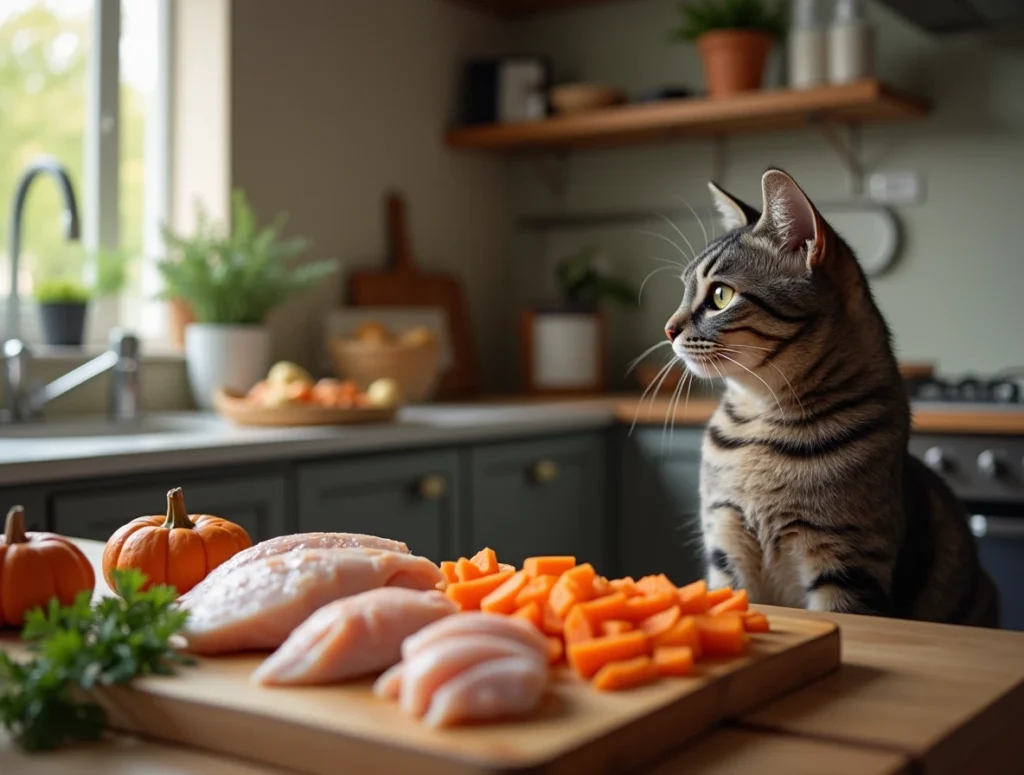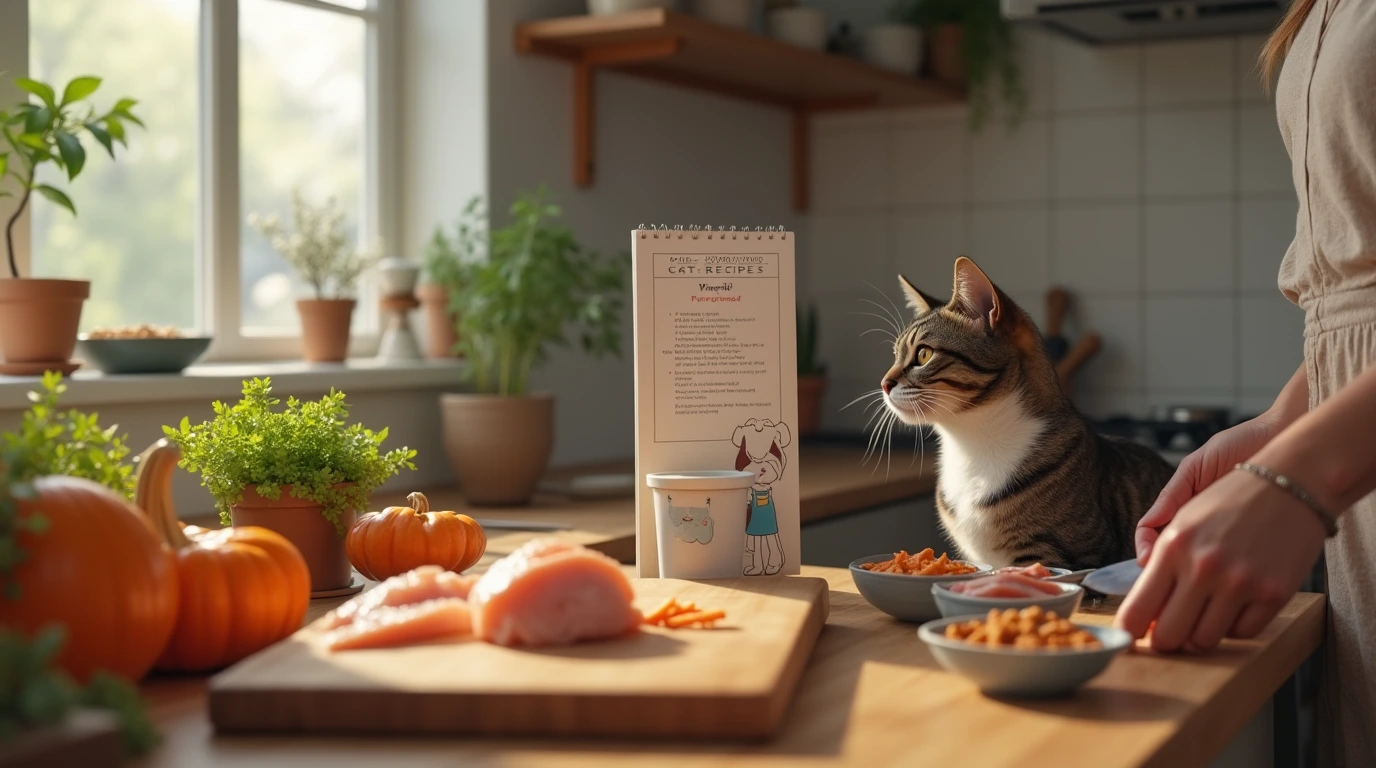Vet-Approved Homemade Cat Food: Nourishing Your Feline the Right Way
As a loving cat owner, your priority is ensuring your furry companion is happy, healthy, and thriving. One of the most impactful ways to achieve this is through their diet. While commercial cat foods offer convenience, they often include preservatives, fillers, or ingredients that may not align with your cat’s unique needs. Cats are obligate carnivores with specific nutritional requirements that are sometimes overlooked in mass-produced food. If you’ve ever felt unsure about what’s really in that bag or can of food, you’re not alone.
Homemade food provides a personalized, nutritious alternative that lets you take full control of your pet’s meals. By crafting dishes tailored to their health needs and preferences, you can avoid unnecessary additives and ensure they’re getting wholesome, high-quality ingredients. With guidance from vet-approved recipes, you can balance taste and nutrition, giving your cat the very best.
In this guide, we’ll break down the essentials of homemade cat food. You’ll learn about your cat’s unique dietary requirements and discover easy, vet-approved recipes that are as healthy as they are delicious. Whether you’re looking to supplement their diet or make a full transition, this guide is your first step to giving your cat a healthier, happier mealtime experience.
Table of Contents
Why Homemade Food is a Great Option for Cats
Your cat deserves the best, and preparing their meals at home ensures just that. Homemade food provides a unique opportunity to prioritize your cat’s health and happiness, offering benefits that store-bought options often can’t match. But what makes this approach so appealing?
Benefits of Homemade Cat Food
- Ingredient Control
You have complete oversight of what goes into each meal, ensuring your cat enjoys high-quality ingredients while avoiding harmful additives or unnecessary fillers. - Customizable for Health Needs
Whether your cat has food allergies, digestive sensitivities, or specific nutritional requirements, homemade recipes allow you to tailor their diet. This flexibility ensures your cat receives the nutrients they need without compromising their health. - Freshness and Flavor
Without preservatives, homemade meals are fresher and packed with natural flavors that cats find irresistible. They’ll look forward to mealtime with enthusiasm.
Imagine the peace of mind you’ll have, knowing that every bite your cat takes is thoughtfully prepared with their well-being in mind. This personalized approach is more than just a meal—it’s a reflection of your love and care for your feline friend, ensuring they live their happiest and healthiest life.

Understanding a Cat’s Nutritional Needs
Before diving into recipes, it’s essential to understand the fundamentals of feline nutrition. Cats have unique dietary needs as obligate carnivores, meaning their bodies are biologically designed to thrive on a meat-based diet. Providing the right balance of nutrients ensures your cat stays healthy, energetic, and happy.
Key Nutritional Components
- Protein
Protein is the cornerstone of a cat’s diet, supplying essential amino acids like taurine, which is crucial for their overall well-being. High-quality sources such as chicken, turkey, and fish provide the nourishment they need to maintain muscle and organ health. - Taurine
This amino acid is indispensable for cats, playing a vital role in supporting heart function, vision, and reproductive health. Unlike other animals, cats cannot produce enough taurine on their own, making it a key component of their diet. - Fats
Healthy fats, particularly omega-3 fatty acids, are essential for energy, maintaining a shiny coat, and promoting brain health. These can be sourced from fish or other animal fats. - Vitamins and Minerals
Nutrients like calcium, Vitamin A, and B vitamins are essential for strong bones, robust immunity, and overall vitality.
While homemade meals offer control and flexibility, achieving a nutritionally balanced diet requires thoughtful planning. In some cases, supplements may be necessary to fill any nutritional gaps and ensure your cat’s health is optimized.
Best Vet-Approved Foods for Cats
Choosing the right ingredients is the cornerstone of crafting homemade meals that are both delicious and nutritionally balanced for your cat. By focusing on high-quality, vet-approved options, you can ensure every bite supports your feline’s overall health and well-being. Here’s what to include:
Protein-Packed Foods
Protein is the most critical component of a cat’s diet. Here are some excellent sources:
- Chicken: A lean, easily digestible protein that most cats find irresistible. It’s low in fat and packed with essential nutrients to support muscle health.
- Fish (Salmon, Tuna): Rich in omega-3 fatty acids, these options promote brain function, a shiny coat, and healthy skin.
- Turkey: A gentle protein ideal for cats with sensitive stomachs or digestive issues.
Veggies That Work for Cats
Although vegetables aren’t a major dietary need for cats, small amounts can provide valuable fiber and nutrients:
- Pumpkin: An excellent source of fiber, it aids digestion and can help alleviate constipation or diarrhea.
- Carrots: Loaded with Vitamin A, carrots support good vision and immune health.
- Green Beans: A low-calorie addition that offers fiber while promoting a feeling of fullness.
Safe Carbohydrates
While carbohydrates should be limited, they can offer energy when used sparingly:
- Rice: A gentle option for cats with sensitive stomachs, rice is easy to digest and can soothe digestive upsets.
- Oats: These provide a small boost of energy and fiber, making them a good choice for occasional use in recipes.
By carefully combining these ingredients, you can craft meals that are not only satisfying but also tailored to meet your cat’s unique dietary needs. Balance is key, so moderation and variety are essential in ensuring long-term health.
Simple Vet-Approved Recipes for Cats
Cooking for your cat doesn’t have to be complicated. Below are easy recipes using vet-approved ingredients.
Recipe 1: Chicken and Rice Delight
Ingredients:
| Ingredient | Quantity | Nutritional Benefit |
|---|---|---|
| Cooked chicken breast | 100g | High-quality protein |
| Boiled rice | 50g | Energy source |
| Mashed pumpkin | 1 tbsp | Aids digestion |
Steps to Prepare
- Shred the Cooked Chicken
Start by taking the cooked chicken breast and shredding it into small, bite-sized pieces. This makes it easier for your cat to chew and digest. - Mix with Boiled Rice and Mashed Pumpkin
Combine the shredded chicken with the boiled rice and mashed pumpkin in a mixing bowl. Ensure the ingredients are evenly blended to create a balanced meal. - Cool to Room Temperature
Allow the mixture to cool completely before serving. Cats prefer their food at room temperature, which also prevents the risk of burns.
Recipe 2: Fish Feast with Veggies
Ingredients:
| Ingredient | Quantity | Nutritional Benefit |
|---|---|---|
| Cooked salmon | 75g | Omega-3 fatty acids |
| Steamed carrots | 1 tbsp | Rich in Vitamin A |
| Green beans | 1 tbsp | Low-calorie fiber source |
Steps to Prepare
- Flake the Cooked Salmon
Begin by flaking the cooked salmon into small, bite-sized pieces. This ensures it’s easy for your cat to eat and enjoy. - Mash and Chop the Vegetables
Mash the steamed carrots until smooth and chop the green beans finely. This step ensures the veggies are manageable for your cat and blend seamlessly into the meal. - Combine All Ingredients
Mix the flaked salmon, mashed carrots, and chopped green beans in a bowl. Stir thoroughly to ensure an even distribution of flavors and nutrients.
Recipe 3: Turkey and Oat Medley
Ingredients:
| Ingredient | Quantity | Nutritional Benefit |
|---|---|---|
| Ground turkey | 100g | Lean protein source |
| Cooked oats | 2 tbsp | Provides fiber and energy |
| Steamed zucchini | 1 tbsp | Low-calorie hydration source |
Steps to Prepare
- Brown the Ground Turkey
Cook the ground turkey in a pan over medium heat, ensuring it browns evenly. Avoid adding any seasoning, as spices can be harmful to cats. - Mix in Cooked Oats and Zucchini
Once the turkey is fully cooked, mix in the cooked oats and steamed zucchini. Stir until all ingredients are well combined, creating a balanced and nutritious meal. - Cool Before Serving
Allow the mixture to cool to room temperature before serving. Cats prefer their food warm or at room temperature for better enjoyment.
Foods to Avoid in Cat Meals
Not all foods are safe for cats, and some can even pose serious health risks. To protect your feline friend, it’s crucial to avoid these harmful ingredients when preparing their meals:
Onions and Garlic
Both can damage your cat’s red blood cells, potentially leading to anemia. Even small amounts can be dangerous over time.
Chocolate and Caffeine
These common human treats are highly toxic to cats, affecting their heart and nervous system. Always keep them out of reach.
Dairy Products
While often associated with cats, many are actually lactose intolerant. Consuming milk or cheese can lead to stomach upset and diarrhea.
Grapes and Raisins
These can cause sudden kidney damage in cats, even in small amounts, making them a critical food to avoid.
Cooked Bones
Splintering cooked bones can pose a choking hazard and potentially harm your cat’s digestive tract.
Always double-check ingredients to ensure your homemade meals are safe and healthy for your cat.
Transitioning Your Cat to Homemade Food
Switching to homemade meals requires patience and care. Sudden dietary changes can upset your cat’s stomach, so take a gradual approach:
- Mix Old and New Foods: Start with a small amount of homemade food mixed into their regular diet.
- Increase Homemade Proportions Gradually: Over a week or two, slowly increase the ratio of homemade food.
- Monitor Reactions: Watch for any signs of allergies or digestive discomfort.
Regular vet visits can help you fine-tune the diet as needed.
FAQ: Common Questions About Homemade Cat Food
Q1: Can I Feed My Cat Only Homemade Food?
Yes, but it’s essential to ensure the diet meets all nutritional requirements. Work with your vet to create a balanced meal plan.
Q2: How Often Should I Feed My Cat Homemade Meals?
This depends on your cat’s age, weight, and activity level. Generally, split their daily portion into two or three meals.
Q3: Do Homemade Cat Foods Require Supplements?
Most likely. Cats need specific nutrients like taurine and calcium, which may require supplementation even in a homemade diet.
Q4: Are Raw Diets Safe for Cats?
Raw diets can pose risks of bacterial contamination. Always consult your vet before feeding raw food.
Conclusion
By preparing vet-approved homemade food, you’re not just feeding your cat—you’re investing in their health, happiness, and well-being. Homemade meals give you complete control over ingredients, allowing you to provide high-quality, nutritious meals that cater to your cat’s specific needs. Whether it’s avoiding allergens, addressing digestive sensitivities, or simply enhancing their diet, homemade food lets you ensure every meal is as wholesome as it is delicious.
This approach isn’t just about nutrition; it’s a way to deepen the bond between you and your feline companion. Cooking for your cat is an act of love, and their gratitude will shine through in every contented purr and enthusiastic mealtime response. With each carefully prepared dish, you’re contributing to their vitality and longevity.
Ready to embark on this rewarding journey? Try one of the recipes shared above, or consult your veterinarian to develop a personalized meal plan tailored to your cat’s unique requirements. Small changes can lead to big results, so don’t wait to start improving your cat’s diet today.
Begin now, and watch as your efforts transform your cat’s energy, coat, and overall health. A happier, healthier life for your furry friend is just a recipe away!.

